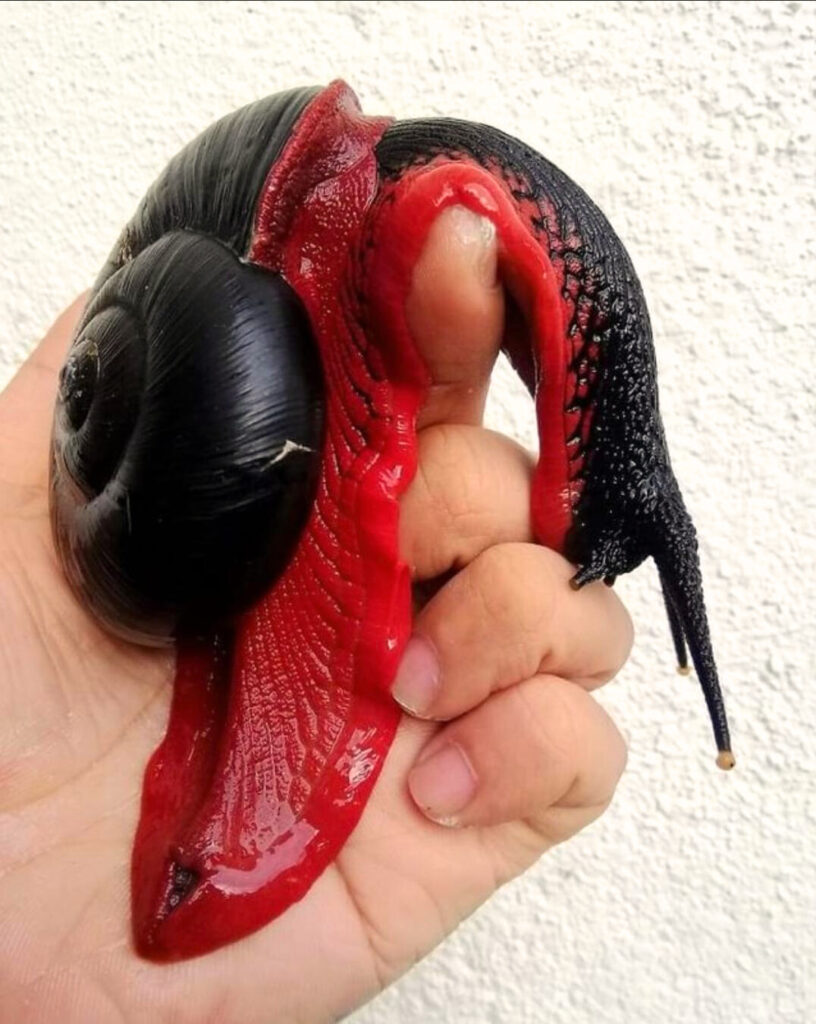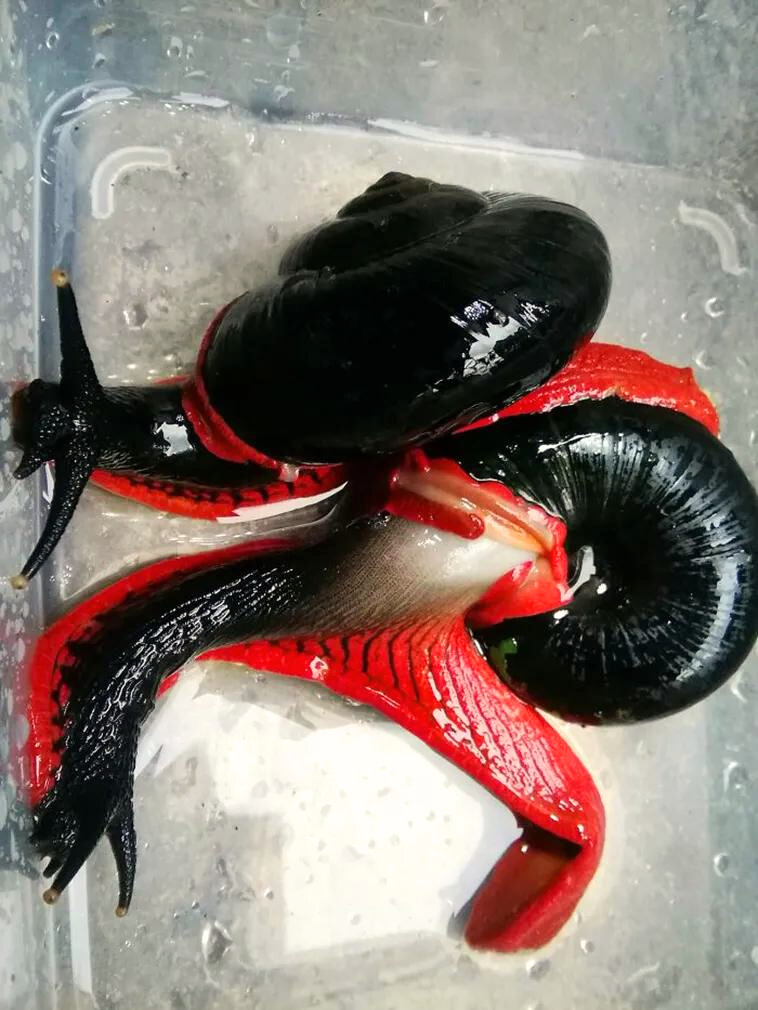Flames of the Forest: The Plight of the Malaysian Fire Snail
Imagine a creature so unique and vibrant, that it seems to carry the very essence of fire within its body. There will be a snail that perfectly fits this description and is largely tucked in the high- altitude forests of Peninsular Malaysia. So here, Malasin Fire Snail is another type of snail that is found in the Malaysian region, it is scientifically called Platymma tweediei. This is a remarkable land snail of medium size and it is easily distinguishable because of its black shell color and rather gays red or orange foot which gives it a rather fiery appearance. Also referred to as the Giant Malaysian snail or the Whipping Snail, the south Asian land snail is exclusive to Malaysia and is known to be among the largest snail species of its kind in south east Asia. Its size can vary, it has a maximum body length of 8 centimeters with shell diameter within the range of 7 to 8 cm. It is well known, stunning in appearance and relatively rare which can make it all the more appealing to researchers and other fans of wildlife.

However, despite the impressive look of the eye-catching and brightly colored Malaysian fire snail, there are many threats to this species. Through the loss of its habitat and with the presence of poachers who intend to sell these lizards for pets, this species faces a delicate status in the ecosystem. This article discusses how the Malaysian fire snail is different from other snails, as well as the importance of establishing a conservation plan that will save this particular species.
1. Introduction to the Malaysian Fire Snail
The Malaysian fire snail, scientifically named Platymma tweediei, is a marvel of nature. Its most striking feature is its black shell, which contrasts beautifully with its vibrant red or orange foot. However, this colouration makes them resemble a small flame navigating through the vegetation, a sight that is quite strange and fascinating. An elongated, spirited red to orange colored foot is another striking feature that makes a snail easily sighted amongst the background of a dark forest floor.
The Malaysian fire snail is found exclusively in the high-altitude forests of Peninsular Malaysia. These forests are located at elevations above 1,000 meters. Simly, it is by providing a cool and moist environment that the snail needs to thrive. These highland forests have some specific conditions necessary in the snail’s environment since these forms of weather provide the preferred level of humidity and temperature that this worm might require. So, they are typically associated with mist, and they can also be seen as being both magical and vital to the snail’s life cycle.

In terms of size, the Malaysian fire snail is quite large for a land snail. Its body can reach up to 8 cm in length, and its shell diameter ranges between 7 and 8 cm. The shell is smooth and glossy, adding to its striking appearance. The snail’s vibrant foot not only serves an aesthetic purpose but also plays a role in its mobility and interaction with the environment. The unique combination of size, colouration, and habitat makes the Malaysian fire snail a truly distinctive species.
2. The Unique Traits of the Malaysian Fire Snail
Scientific Significance
The Malaysian fire snail, known scientifically as Platymma tweediei, holds a unique position in the world of gastropods. Platymma is a genus of moths, and this one is the sole species in the genus Platymma. The term Platymma is derived from the Greek words Plat u and Ommate, where Plat or ‘broad’ refers to the form of the eyestalk, while Ommate means ‘eye’. This classification emphasizes it as an exotic and scientifically valuable plant because it is the sole member of its genus in the world, and this fact represents significant interest for those researching the concept of species’ plurality and evolution.
Visual Appeal
One of the most striking features of the Malaysian fire snail is its vivid colouration. Bright red or orange color of the foot combined with the black shell shows rather poor contrast yet it resembles a flame when seen with the naked eye. This external show however is not merely for mere display, rather it significantly aids in the increased visibility of the snail. This is also contributing to its appeal to lovers of nature and biologists alike. Snail has a rather vivid colouration which would allow the creature to be noticed easily against dark green big leaves of the plants and the dark forest floor in case a lucky person will be lucky to meet it in the wild.

Ecological Role
While detailed studies on the ecological role of the Malaysian fire snail are limited, land snails in general play crucial roles in their ecosystems. It is therefore important for nutrient recycling on the preservation of the health of the forest ecosystem. Moreover, they are consumed by birds, mammals and insects as well, and therefore, have an efficient role in feeding food chain as well. The Malaysian fire snail, whose testate appearance seems to be singular to sunken lands, probably performs this function, thereby maintaining the equilibrium of the highland-forest ecosystem.
In highlighting these unique traits, it is possible to discuss not only the aesthetic and, in a way, singular value of the Malaysian fire snail but also its role within the species’ environment. This knowledge contributes to the understanding of its importance to be preserved and served with additional efforts.
3. The Threats to the Malaysian Fire Snail
Habitat Destruction
Due to loss of habitats the Malaysian fire snail is living in a very dangerous position as it can be wiped off any type of existence easily. The habitats of them are high-altitude forests that have a limited distribution being found only in Peninsular Malaysia and are diminishing. Logging, agriculture, and urbanization are some of the major causes threat to these habitats through the process of deforestation. While fire snails feed on aquatic plants and lives in water, the manipulation of this environment through cutting down trees and clearing of land affects the system it thrives in. The deforestation has a double jeopardy on the snail because alongside the reduction of habitat it affects the microclimate of the area and this is inhospitable for this species of snail.
Illegal Poaching
In addition to habitat loss, the Malaysian fire snail faces the threat of illegal poaching. Its striking appearance has made it a target for collectors and the exotic pet trade. These snails are hunted by poachers to sell to other people who use them when they are rare since they have beauty in them. This trade has adverse effect on the snails because they are captured from their natural habitat and people acquire them in the black market, implying that their populations in the wild are decreased. This is a reprehensible practice which further jeopardizes the existence of this species since it will take ages for snails – known to reproduce slowly – to reproduce to the increased number again.

Conservation Status
Currently, the Malaysian fire snail is not officially classified as endangered. However, its rarity and the observable decline in its population are alarming. The combination of habitat destruction and illegal poaching has led to a noticeable decrease in its numbers. Conservationists are concerned about the long-term survival of the species, even though it hasn’t been formally listed as endangered. The scarcity of the snail in its natural habitat is a clear indicator that without immediate and effective conservation measures, the Malaysian fire snail could soon face a more critical threat to its survival.
The unique beauty and ecological role of the Malaysian fire snail underscores the urgency of protecting it from these threats. Ensuring its survival requires concerted efforts to preserve its habitat and curb illegal poaching.
4. Conservation Efforts
Current Initiatives
A conservation drive that seeks to protect the Malaysian fire snail is starting to receive some attention across the globe gradually. Several international environmental agencies and local governments are also doing everything to protect the habitat of this beautiful species. The first major initiative can be referred to protection of specific territories in specific high altitude forests of Peninsular Malaysia. These areas are protected in that the driving forces behind deforestation, particularly logging and land clearing, are prohibited to conserve the snails habitats. Moreover, awareness creation efforts such as public outreaches and policy sensitization are being undertaken to improve the community’s and policymakers’ understanding of the need to conserve both the species and its natural environment.

Community Involvement
Local communities play a crucial role in the conservation of the Malaysian fire snail. By involving residents in conservation activities, these efforts become more sustainable and effective. Another is through community participation where people within a given community are encouraged to engage in practices that improve the size of habitats, the extent to which habitats are protected, or the rate at which they replenish themselves naturally. Awareness creating activities like teaching, seminars which include training also facilitates the people with the knowledge and encourages them to save the snail and its habitat. Furthermore, advocating for environmental tourism gives another form of livelihood hence not putting much pressure on the forest fauna and wherein lies the significant quam of making the locals become much more inclined to preserve the forests.
Scientific Research
Scientific research is essential for the effective conservation of the Malaysian fire snail. Ongoing studies focus on understanding the snail’s biology, behaviour, and ecological requirements. Researchers are also studying effects on just populations, due to habitat loss and other factors such as global warming. These studies hold useful information deemed important when coming up with practical and strategic actions in the conservation of wildlife. Further research is required on how to establish further breeding of captives for eventual release to supplement the existing effort. It is crucial to have interaction and cooperation of scientists, conservationists, and local communities in the process of data collection and subsequently in the successful conservation programme.
5. The Importance of Conservation
Biodiversity
Biodiversity is the foundation of a healthy and resilient ecosystem. Each species, no matter how small or seemingly insignificant, plays a crucial role in maintaining the balance of its environment. Moreover, the Malaysian fire snail does not deviate from this statistic. When it comes to the functioning of the forest ecosystem, this animal plays a role of decomposers, which recycle nutrients from the organic matter ensuring adequate supply of the nutrients in the soil. All those activities serve for advancing and developing plant life and take care of the forest’s health. This smaller creature needs protection in order to maintain the delicate balance of life which is supported by these Malaysian forests.
Ecotourism
Ecotourism presents a valuable opportunity to support the conservation of the Malaysian fire snail while benefiting local communities. By promoting sustainable tourism, people get to enjoy the other natural endowment of Malaysia in particular with the highland forests and some of the special species found in the region. Another way through which ecotourism is beneficiary is through income generation to local communities which in return offer to conserve natural resources. Consumers, with the help of professional guides, can familiarize themselves with the principles of natural reserve protection as well as peculiarities of the fire snail. It goes further than that but also helps people learn about the subject, fund projects that will lead to conservation and boost the economy of the area.

Future Prospects
Looking forward, there is hope for the Malaysian fire snail’s survival. Continued efforts to protect and restore its habitat are essential. It must also be noted that further action should be taken to save and rejuvenate the area that this animal calls home. Other ways to accustom this animal include strict policies against acts of illegal poaching and proper encouragement for programs in breeding these animals in captivity. Education and sensitization of the community will go a long way in ensuring the reduction of negative impacts through alteration of the behaviors of the locals. Through an amalgamation of these efforts, then, we would be constructing a future where the Malaysian fire snail can continue a natural existence
Conclusion
The Malaysian fire snail, with its striking black shell and vibrant red or orange foot, is a unique and rare species found only in the high-altitude forests of Peninsular Malaysia. This remarkable snail faces significant threats from habitat destruction and illegal poaching, putting its future at risk. Conservation efforts, including habitat protection, community involvement, and scientific research, are crucial for its survival. Additionally, promoting ecotourism can benefit both the snail and local communities, fostering a sustainable approach to conservation.
To help protect the Malaysian fire snail, you can support conservation organizations working in Malaysia, spread awareness about the species, and advocate for stronger environmental protections. Educating others about the importance of biodiversity and the unique role of the fire snail can also make a difference. Consider visiting Malaysia to experience its incredible biodiversity firsthand and support ecotourism initiatives that benefit local communities and conservation efforts.
Also you can read an article about Hidden in Plain Sight: The Leaf Gecko’s Incredible Camouflage and more amazing articles in our website Bamboospanda.























